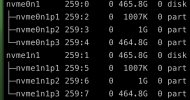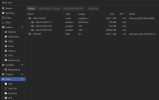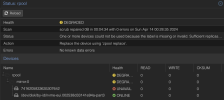Hi,
I run a proxmox homelab, and have the proxmox installed on 2 SSD's in a ZFS mirror. I also store my VM's on the host drive, but that shouldn't be relivant to what I need to do.
I am somewhat fmailular with ZFS, but really only in truenas where there are simple GUI options to manage everything. With Proxmox, what I need to do is pop in a 3rd (temporary SSD), replicate the mirror to that drive, and then remove the failing boot drive. This will retain my 2 way mirror, but will allow me to remove the failing drive to get it RMAed and replaced. In truenas this is pretty easy, but I am unsure how to go about this in Proxmox since the system boots from this ZFS pool...
Are there any instrucitons on how to do this? I can't seem to find a simple step by step example of how to go about this.
It looks like I am using proxmox boot tool:
So it looks like I do:
I am a bit conufsed, what is the <old zfs partition> and <new zfs partition>, and what is <new disk's ESP>?
I run a proxmox homelab, and have the proxmox installed on 2 SSD's in a ZFS mirror. I also store my VM's on the host drive, but that shouldn't be relivant to what I need to do.
I am somewhat fmailular with ZFS, but really only in truenas where there are simple GUI options to manage everything. With Proxmox, what I need to do is pop in a 3rd (temporary SSD), replicate the mirror to that drive, and then remove the failing boot drive. This will retain my 2 way mirror, but will allow me to remove the failing drive to get it RMAed and replaced. In truenas this is pretty easy, but I am unsure how to go about this in Proxmox since the system boots from this ZFS pool...
Are there any instrucitons on how to do this? I can't seem to find a simple step by step example of how to go about this.
It looks like I am using proxmox boot tool:
Re-executing '/usr/sbin/proxmox-boot-tool' in new private mount namespace..System currently booted with uefi1249-18B5 is configured with: uefi (versions: 6.2.16-20-pve, 6.5.11-7-pve, 6.5.13-1-pve, 6.5.13-3-pve)1249-7D78 is configured with: uefi (versions: 6.2.16-20-pve, 6.5.11-7-pve, 6.5.13-1-pve, 6.5.13-3-pve)So it looks like I do:
# sgdisk <healthy bootable device> -R <new device># sgdisk -G <new device># zpool replace -f <pool> <old zfs partition> <new zfs partition># proxmox-boot-tool format <new disk's ESP># proxmox-boot-tool init <new disk's ESP> [grub]I am a bit conufsed, what is the <old zfs partition> and <new zfs partition>, and what is <new disk's ESP>?





